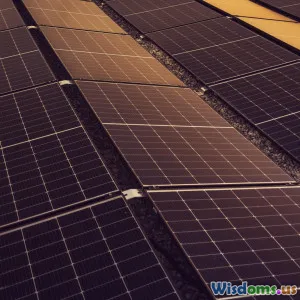
The Impact of Technology on Filmmaking
8 min read Explore how technology revolutionizes filmmaking, from production to distribution, reshaping creativity in the movie industry. (0 Reviews)
The Impact of Technology on Filmmaking
Filmmaking has always been an art intertwined with the tools and technologies accessible at the time. From the silent black-and-white movies to today's hyper-realistic CGI spectacles, technology consistently serves as a pivotal driver of cinematic evolution. In the 21st century, rapid technological advancement doesn't just support filmmaking — it defines it. This article dives deep into how technology has transformed every phase of moviemaking, revolutionizing everything from storytelling to production to distribution.
The Digital Revolution: A New Era of Cinematic Craft
Digital Cinematography and Editing
A few decades ago, shooting a film involved bulky and expensive celluloid cameras, which presented limitations such as film roll length, chemical processing costs, and editing constraints. The shift to digital cinematography has democratized filmmaking. High-definition digital cameras like RED, Arri Alexa, and Sony Venice deliver breathtaking image qualitywith vastly reduced costs. Indie filmmakers and major studios alike now enjoy greater flexibility, longer shooting times, and immediate playback.
Editing has similarly undergone a revolution. Traditional manual cutting and splicing are relics, replaced by nonlinear editing (NLE) software such as Adobe Premiere Pro and Avid Media Composer. Editors have unprecedented control with tools including color grading, motion graphics integration, and multi-layer audio editing.
Steven Soderbergh, an acclaimed director, stated, “Digital technology has freed us from the tyranny of film stock,” enabling faster and more innovative storytelling.
Computer-Generated Imagery (CGI) and Visual Effects (VFX)
CGI is perhaps the most visible transformation technology has brought to filmmaking. Groundbreaking films like the original Jurassic Park (1993) introduced photorealistic dinosaurs blending storytelling with science. Now, sophisticated VFX software—from Autodesk Maya to Houdini—creates astonishing sequences once inconceivable.
Aside from blockbusters, CGI empowers niche genres like fantasy and sci-fi to build immersive worlds. Films like Avatar (2009) combined motion capture with CGI to create not only fantastical characters but entire planets, launching new paradigms for immersive cinematic experiences.
Motion Capture and Performance Capture
Advances in motion capture technology also blur the lines between live-action and digital performances. Actors wear suits embedded with sensors to record nuanced movements and facial expressions, which animators apply to digital characters. Andy Serkis’s portrayal of Gollum in The Lord of the Rings exemplifies how this technology brings digital characters to vivid life.
Interactive and Immersive Technologies Transforming Storytelling
Virtual Reality (VR) and Augmented Reality (AR)
In the last decade, VR and AR have unlocked unprecedented interactive storytelling possibilities. VR films immerse audiences inside the narrative, enabling 360-degree exploration. For example, Pearl, an Oscar-nominated VR short, places viewers at the center of an emotional road trip.
AR meriting applications also emerge in movies, where real-world environments blend with digital overlays to enhance promotion or immersive experiences connected to a film’s universe. These technologies nurture active participation rather than passive viewing.
Artificial Intelligence (AI) in Filmmaking
Artificial intelligence tools assist filmmakers in pre-production planning, script analysis, and even casting decisions based on data insights. AI-driven software analyzes scripts to predict audience appeal or optimize shooting schedules. These innovations improve efficiency, reduce costs, and tailor content to viewer preferences.
Distribution and Exhibition Disrupted by Technology
The Streaming Revolution
Technology hasn't just altered production but has giant implications for how audiences access movies. The rise of streaming services such as Netflix, Disney+, and Amazon Prime Video has disrupted traditional theatrical distribution models, providing filmmakers direct access to global audiences.
Streaming platforms have also expanded content diversity by funding projects outside conventional Hollywood molds, promoting inclusivity and innovation. According to a 2023 survey, over 80% of viewers preferred streaming movies to cinemas post-pandemic, indicating a sweeping cultural shift.
Digital Projection and Exhibition
Technological upgrades in theaters, including 4K and 8K digital projection and IMAX laser systems, deliver higher fidelity and immersive experiences that rival home setups. However, this also pressures filmmakers to adopt cutting-edge filming techniques—such as higher-resolution cameras and HDR imagery—to maximize visual impact.
Democratization and Challenges
Lower Barriers Mean More Voices
Technology’s biggest triumph arguably is democratizing filmmaking. Smartphones equipped with 4K cameras and affordable editing apps have transformed aspiring creators into storytellers. Social media platforms also act as distribution networks, reducing reliance on traditional gatekeepers.
This shift fuels genre diversity, new talent emergence, and experimental formats, fundamentally enriching the cinematic landscape.
Challenges: Over-Reliance and Ethical Concerns
Despite many positives, technology raises challenges. Overdependence on CGI can sometimes overshadow story and character development, leading to spectacle-prioritized films. Ethical issues around deepfake technology and AI-created content raise questions about authenticity and copyright.
"Technology should serve storytelling, not the other way around," remarks filmmaker Christopher Nolan, reminding the industry to balance innovation with artistic integrity.
Conclusion: A Dynamic, Evolving Film Industry
Technology remains a double-edged sword in filmmaking: a powerhouse enabling dazzling visual storytelling and broader inclusion on one side, with risks of creative dilution on the other. From shooting on digital cameras and crafting near-real worlds via CGI, to exploring immersive VR narratives and changing how audiences connect with movies through streaming, technology’s footprint is undeniable.
Filmmakers who master these tools while preserving core storytelling values will lead cinema into exciting new frontiers. As viewers, embracing these advancements opens gateways to richer, more engaging experiences. The future of filmmaking promises a thrilling blend of art and science, where our favorite stories come alive in ways once only imaginable.
References
- Soderbergh, S. Interviews on digital filmmaking techniques, 2018.
- Jurassic Park visual effects history, Industrial Light & Magic archives.
- Academy Awards 2017, VR category highlighting Pearl.
- Nielsen Streaming Trends Report, 2023.
- Nolan, C. Filmmaking panels and interviews, 2021.
Explore the evolving relationship between technology and art — where blockbuster visuals meet heartfelt narratives to redefine cinema for new generations.
Rate the Post
User Reviews
Popular Posts





















